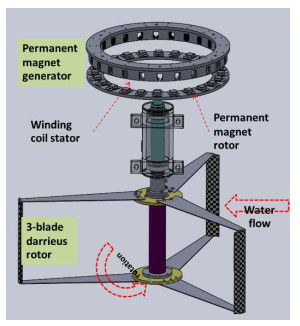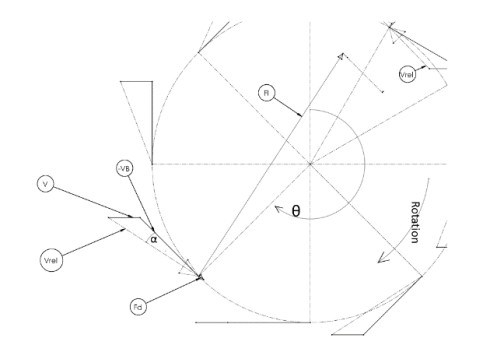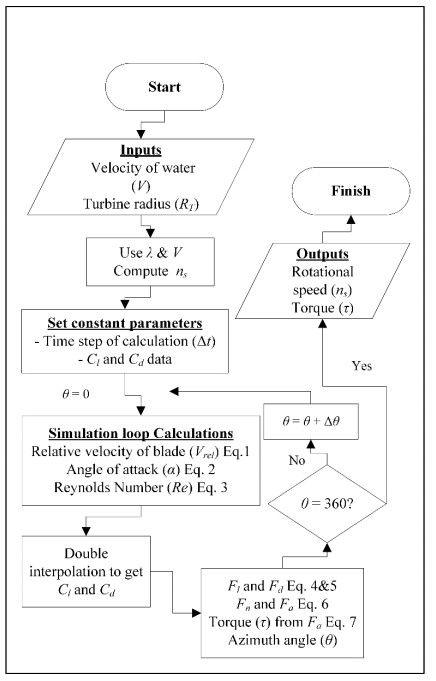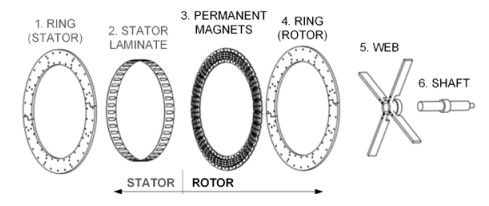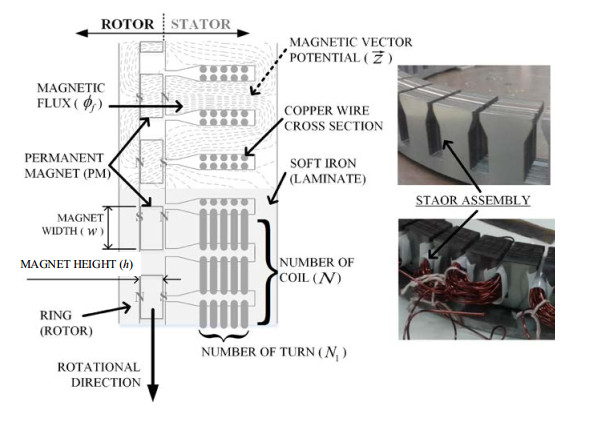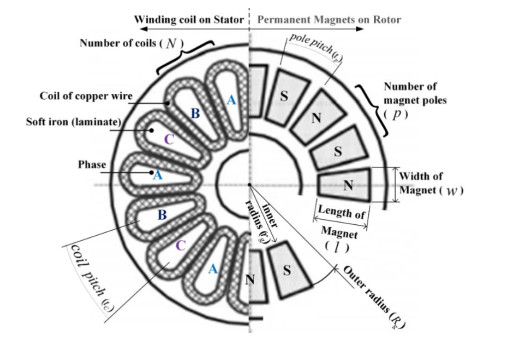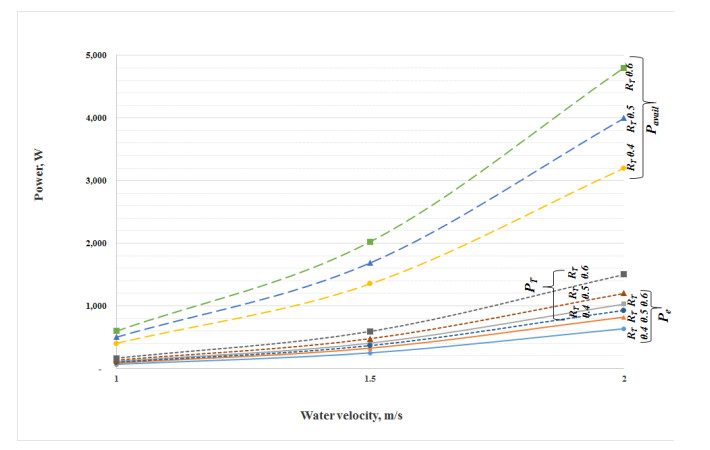This research project investigates the impacts of the rotor and generator sizes on rotational speed and voltage output of a direct-drive hydrokinetic turbine system. It searches for a possibility of reducing the generator size while possessing the capability to produce sufficient voltage at an ultra-low RPM. The system has a Darrieus rotor that directly drives an axial-flux permanent-magnet generator, hence the friction loss from the transmission system is eliminated. However, the direct-drive system possesses a very low rotational speed, which adversely affects the generator. In particular, the output voltage is not sufficient for regular applications or the generator diameter needs to be enlarged. Numerical models of the rotor and generator were constructed in MATLAB. The rotor and generator sizes were varied under several design conditions. The models delivered design parameters for the system and their relationships. It was found that designing the generator with 50/60 Hz electrical frequency limits the number of slot/phase and hence the maximum output voltage. The study makes a case for designing a generator with electrical frequency other than the standard frequency, where it would be novel to be able to produce a higher voltage when a location with high water velocity is available, in addition to an improved power production. It would allow the generator to produce higher voltage at a given water velocity and rotational speed or have a smaller diameter at a given output voltage.
1.
Introduction
Hydropower is one of many renewable energy sources. The widely used form of hydropower is obtained from potential energy stored in water behind dams, but due to their adverse effects on forests [1] and public perception, they are now rarely built. However, there are other forms of hydropower called hydrokinetic power: wave, tidal and stream [1]. Hydrokinetic power turbines extract kinetic energy from a flowing mass of water, which is akin to wind turbines. However, because water is denser than air, there is more energy to be extracted from the same swept area. This idea has received a lot of interest from researchers due to its lower costs and minimal civil constructions. Turbines can be installed in rivers or channels where water flows. Rivers with high water velocity are suitable locations, but they are usually in remote areas. Therefore, the systems must be durable and simple to maintain by local people. Hydrokinetic turbines have 4 major components; a turbine rotor, a transmission shaft, a gearbox and a generator. The generator is normally of the radial-flux type, which operates at above 1500 RPM [2], but the turbine rotor spins at a much lower speed. Thus a gearbox is required. As a result, there is an approximately 10% [3] loss of energy. Hydrokinetic Darrieus turbines produce mechanical power at lower rotational speeds compared to Darrieus wind turbines. A Darrieus wind turbine wind tunnel test [4] showed that the turbine starts to produce power at over 60 RPM while a simulated Darrieus hydrokinetic turbine works at 70 RPM and below [5]. As a result, applying a direct-drive system to it would be a challenging task. The said turbine is 4 m in diameter, however, if the diameter is 2 m, the rotational speed becomes 140 RPM. There is a narrow window of peak power output at each water velocity, where the generator must be designed to operate within.
If a direct-drive system could be implemented, it would eliminate the friction loss at the gearbox, but the generator speed would become too low for power generation. In such a system, the Darrieus rotor drives a permanent magnet rotor, while the armature coil stator is stationary [6]. Directly-driven axial-flux generators have been tested with wind turbines and hydrokinetic turbines. Table 1 shows the performances such as water velocity (V), turbine radius (RT), rotational speed (ni) and electrical power output (Pe) of hydrokinetic turbine systems. Davila-Vilchis and Mishra (2014) [2] tested a generator at 420 RPM, where it produced 47 W of Pe. Bannon et al. (2013) [7] designed a similar generator at a speed as low as 22 RPM, and the Pe was estimated to be 6.9–803.6 W (at 22–92.3 RPM).
The main factors influencing the voltage and current outputs are the relative speed between magnets and coils and the generator torque, respectively. The former is also directly proportional to the number of turns of copper in the armature coils. A group of researchers [13,14,15] have illustrated that it is possible for a generator to produce Pe at low ni. They conducted an experiment with a direct-drive permanent-magnet generator (PMG) in a wind turbine system that was operated at 127 RPM. However, direct-drive hydrokinetic turbines operate at a much lower speed [16]. Firstly, the Darrieus rotor has to operate at its designated tip speed ratio (λ) [17,18], corresponding to the maximum power coefficient (CP), while the generator has to produce a sufficient voltage. The problem arises when the Darrieus rotor diameter is large, which forces the ni to drop. As a result, the generator diameter must also be increased to maintain the relative speed between magnets and coils. However, the impacts of the turbine rotor and generator sizes on ni and Pe have not been fully explored. This research project seeks to provide a solution and supporting data that would allow engineers to keep the generator size compact, while making sure that the system could provide sufficient voltage.
The objective of this project was to study the parametric relationship between rotor and generator sizes of a direct-drive hydrokinetic turbine system and to investigate a way to reduce the generator size while possessing the capability to produce sufficient voltage at an ultra-low RPM. The system used a 3-blade Darrieus rotor to drive an axial-flux permanent-magnet generator directly. Simulation programs were constructed in MATLAB to compute parameters of the Darrieus rotor and the generator. The Darrieus rotor simulation program obtained hydrodynamic parameters such as forces on the turbine blade, ni, torque (τ) and CP. The data were then input into the axial-flux permanent-magnet generator simulation program and the output voltage and Pe delivered calculated. The performances of the system at various rotor and generator diameters are reported in this paper. A suggestion on generator electrical frequency is put forward, which would facilitate a novel and more suitable generator for this application.
2.
Research methodology
The direct-drive hydrokinetic turbine system consists of a 3-blade Darrieus rotor and an axial-flux permanent-magnet generator (Figure 1). The Darrieus rotor has a shaft that is connected to the permanent-magnet rotor of the generator. The armature coil stator is fixed. The numerical simulation was divided into 2 parts: Darrieus rotor simulation and axial-flux permanent-magnet generator simulation. The former provided inputs for the latter; those inputs being ni and τ. The simulation programs were written in MATLAB. This investigation performed analyses on rotors at a constant ni. It assumed that the rotors were started and brought up to speed by a mechanism. The energy associated with the process would be very small compared to the total energy production.
2.1. Darrieus rotor simulation
The Darrieus rotor simulation program calculated the hydrodynamic parameters at several values of RT and V. The λ used is approximately 6 [19] and hence its nominal speed (ns) at each V was determined. As the rotor turned at the speed of ns, the blades were at various angles of attack (α). The vector of relative velocity (Vrel) and α changed constantly, which was used to find the lift (Cl) and drag coefficients (Cd) [20]. These blade data belong to the NACA 0018 blade profile and were built into the program [21]. The program calculated lift (Fl), drag (Fd) (Figure 2) and resultant forces (Fr) on the blades. The normal (Fn) and tangential (Fa) forces led to the τ produced by the rotor. The outputs of the Darrieus rotor simulation program were ns and τ at various conditions (Figure 3).
At a given θ and ni, the VB was calculated using Eq 1.
Vectors of V and VB were provided to obtain Vrel and α using Eqs 2 and 3, respectively.
The vector of Vrel and α changed constantly, which was used to find the Cl and Cd. The instantaneous Re was computed according to Eq 4. The written program used this data to interpolate for Cl and Cd from the NACA 0018 data file [21] before calculating the Fl and Fd using Eqs 5 and 6.
Lastly, Fa was obtained using Eq 7, where it is responsible for τ, which was obtained for every blade using Eq 8. The next instantaneous θ was computed after Δt had passed and so the iteration proceeded (Figure 3). The outputs of the Darrieus rotor simulation program were ns and τ at various conditions.
2.2. Axial-flux permanent-magnet generator simulation
The basic design of the generator is shown in Figure 4, where the permanent-magnet rotor is connected to the Darrieus rotor via a shaft. The magnet size was fixed and the number of magnets varied with generator radius (Rg). The stator had laminate sheets packed together to produce the core for the coils. The rotor and stator were assembled with an air gap of 1 mm. Detailed dimensions of common parts (Figures 5 and 6) were specified before calculations took place. A mathematical model of the axial-flux permanent-magnet generator was built, where ns was the primary input. Even though ns is dictated by the turbine, it directly affects p of the generator. Rg was varied (Table 2), which directly affected the number of slots (N). The stator winding was of the concentrated winding type. Therefore, the key parameters of the generator were ns and Rg.
The coil to pole ratio (N/p) was kept constant. The electromagnetic potential (Ef) for each case was computed and compared.
The generator has to produce power at electrical frequency (f) = 50 Hz, which means the number of pole pairs (p) was computed using Eq 9 [22]. ns from each RT was obtained from the hydrokinetic rotor analysis.
Then Ef was estimated using Eq 10 [22], which clearly states that it is proportional to ns, while keeping N1 as 1.
where N1 is the number of turns in series per phase, kw1 is the winding factor and ϕf is the Magnetic flux/pole.
Moreover, kw1 and ϕf must also be obtained using Eqs 11 & 12 [22].
where m1 is the number of phases, β is the coil pitch to pole pitch ratio, q1 is the slot per pole per phase, Bavg is the averaged flux density and rg is the generator inner radius.
The generator produces a 3-phase AC voltage which has to be converted into a DC voltage (Vdc) using a full-wave rectifier. Equation 13 [22] represents the AC-DC electrical conversion. This voltage can be applied to loads such as a resistive heater, a battery charger or a DC-to-AC inverter.
3.
Results
3.1. Darrieus rotor hydrodynamic performance
For each V, RT was varied and ns was obtained while keeping the λ at 6. The Darrieus rotor simulation program solved for ns and τ, which were needed for the generator simulation program. It has to be noted that the rotors in all the cases have the same solidity. This entails that rotors with small RT would have blades with short chord lines and vice versa. The data show that τ is directly proportional to V and RT (Table 3), which means a fast moving stream and large rotor are desirable for a hydrokinetic power application in general. However, large rotors will spin even slower with low ns. The relationship between RT and ns is dictated by the need to have a constant λ, which corresponds to the maximum Cp.
At the same water velocity, Cp improved only slightly with RT. For instance, rotors with RT = 0.6 m produced more τ and better Cp, whereas higher water velocity did help in Cp gain by as much as 20% from V = 0.5 to V = 2.0 m/s. In the deployment of the turbine system, we would measure the water velocity and then proceed with a rotor design. A rotor configuration with RT = 0.6 m would be chosen, but we run the risk of not being able to find a PMG design that produces usable voltage due to the ensuing low ns.
3.2. Axial-flux permanent-magnet generator performances
The generator simulation yielded Ef when Rg was varied. At each V, RT and Rg were essentially redesigned to find a set up that gives Ef at a usable level. It was found that Ef rises in proportion to Rg. At Rg = 0.2 m, Ef was 1.26 V/turn/coil/phase. When Rg is 3 times larger (at the same V), Ef went up by approximately the same factor (Table 4). The total voltage per phase becomes Ef multiplied by the number of turns in series per phase (N1). The value of N1 will increase when there is a higher number of coils and larger slot to accommodate conductors.
In addition, Ef became independent of V and RT because f was fixed at 50 Hz. In other words, an installation with high V will deliver improved power production, while a larger RT gives higher τ, but the consequential system configuration contributes no change to Ef compared to another configuration installed at a lower V. However, N was directly affected, the reason being that as ns changed with V and RT, N must be adjusted to keep f at 50 Hz.
Moreover, Pe was strongly influenced by RT and V. For instance, at V = 1 m/s and RT = 0.6 m, the available power in the water (Pavail) was 600 W but Pe was 112 W (Figure 7). However, at double the water velocity (V = 2 m/s), the turbine system was predicted to produce Pe = 1,028 W. Likewise, when RT was lowered to 0.4 m, Pe dropped to 636 W.
The estimated Pe and the required N1 were obtained (Table 5) from the generator numerical model, which assumed resistive wires as a load. The overall output of the system could be raised by increasing RT. It was also found that a generator with small Rg required more turns of conductor to produce the same level of usable voltage. The findings suggest that to have sufficient power, the system should be installed in rivers with V of at least 1.5 m/s.
Not all PMG designs from this analysis are suitable for production. For a practical reason, putting 125 slots/phase (Table 4) into a generator with Rg of 0.2 m may be challenging. A more attainable number of slots is 31 slots/phase, and hence the voltage per phase per turn is 39.06 Vrms or 35.18 Vdc (Eq 13). This level of voltage is usable for battery charging applications, and so the design character is desirable.
A direct-drive hydrokinetic turbine system has an inherent low voltage output due to its low ns. It would be novel to be able to produce more voltage when a location with high water velocity is available, in addition to an improved power production. However this is currently not the case because f is strictly maintained at 50 (or 60) Hz. In such a case where high water velocity is available, the turbine unit would be redesigned specifically for the site. The rotor would be able to produce more mechanical power and the generator to output more electricity, albeit at the same Ef.
We want to be able to redesign the turbine unit to take advantage of the increased water velocity in all dimensions. A solution would allow engineers to either design a generator that produces higher voltage at a given V and ns or a generator with smaller Rg at a given Ef.
For illustration, the current generator designs have high ns at higher V. Fixing f at 50 Hz gives N = 31 at V = 2.0 m/s (Table 4). If we assume that at Rg = 0.2 m, there is enough space on the circumference to put in more slots. According to equation 8, it is possible to have f = 100 Hz and 62 slots/phase rather than 31 slots/phase. As a result, the voltage per phase per turn is 78.12 Vrms or 70.36 Vdc. The actual number of slots that Rg could accommodate must be investigated further.
On the other hand, if high Ef is not needed, Rg could be halved. It is also possible for the generator to output almost the same level of Ef as before by having Rg equal to 0.1 m while keeping f = 100 Hz and 31 slots/phase. Although the voltage per phase per turn may not be as straightforward as before, the generator could be made more compact. The complication comes from the compounding effects of a lower number of slots and the relative speed between the permanent magnets and the armature coils.
This study found that there is a need to design a generator whose electrical frequency is anything rather than 50 Hz. By allowing the frequency to increase, the generator could be producing higher usable voltage at the same diameter or the same voltage at a smaller diameter. At the current state of generator design, an off-the-shelve PMG is not suitable for the direct-drive hydrokinetic turbine system, because it cannot fully utilize the benefit of increased water velocity.
4.
Conclusions
This research project formed numerical models of a hydrokinetic Darrieus rotor and an axial-flux permanent-magnet generator. The outputs of the rotor model were ns and τ, which were then fed into the generator model. The combined system became a direct-drive hydrokinetic turbine system, where a transmission system was left out and hence friction loss was eliminated. To produce sufficient voltage and power, Rg was enlarged. The design parameters of the rotor and generator are presented. The study particularly indicates Rg and N1 values necessary for the generator to produce usable outputs. Turbine system configurations were obtained, for which estimated power outputs were also compared.
It was found that Ef became independent of V and RT because f was fixed at 50 Hz. As a result, this study made a case for designing a generator with electrical frequency other than the standard frequency, where it would be novel to be able to produce more voltage when a location with high water velocity is available, in addition to an improved power production.
This investigation used models with moderate complexity to prove the idea of a direct-drive hydrokinetic turbine system. It presented key parameters for an experiment which will be carried out in the near future. In the meantime, the models must be developed further to cover all aspects of operation. For example, the rotor model should have hydrodynamic data from a 3-D rotor simulation and experimental data. Moreover, the generator model could be improved by having 2-D magnetic flux simulation data. All models would be integrated into a single model, which should help to design a direct-drive hydrokinetic turbine system to suit a wide range of flow conditions.
The rotor sizes (RT) are 0.4–0.6 m because they dictate ns to be 72–191 RPM. The literature review shows that there was only one study at 65 RPM among many low-speed hydrokinetic turbine systems (Table 1). This study performed analyses at these speeds before attempting to lower ns in the future. Although, RT could be smaller, this would result in the blades being too thin (if the solidity is to be kept constant) and fail during operation. On the other hand, Rg should be as large as possible but since this research team had built a test generator whose dimensions were restricted by the available machineries and tools in the laboratory. This study took the test generator as the reference.
Acknowledgments
This research was sponsored by the National Research Council of Thailand (NRCT), Thailand through Research and Technology Transfer Affairs, KKU. Grant number 600038.
Conflict of interest
The authors declare no conflict of interest.









 DownLoad:
DownLoad:
